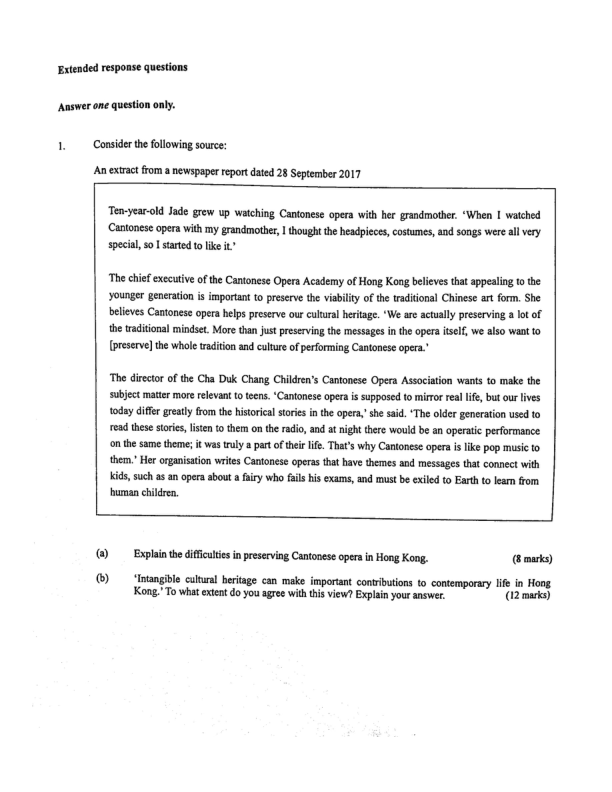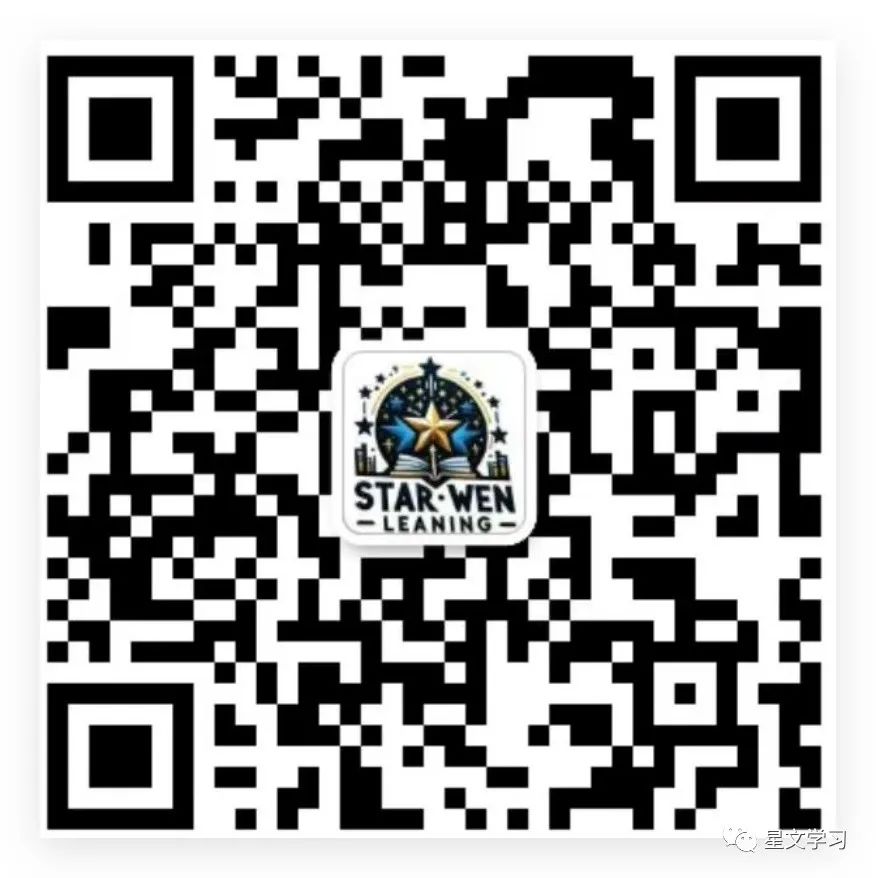2020 DSE 通识教育-LiberalStudies 真题 答案 详解
2020-05-07 dse dse 通识教育-LiberalStudies
| 序号 | 文件列表 | 说明 | ||
|---|---|---|---|---|
| 1 | 2020-通识教育-LiberalStudies-answer-zh.pdf | 10 页 | 15.14MB | 答案(中文) |
| 2 | 2020-通识教育-LiberalStudies-answer-eng.pdf | 22 页 | 13.13MB | 答案(英文) |
| 3 | 2020-通识教育-LiberalStudies-paper1-zh.pdf | 7 页 | 1.73MB | 真题 Paper 1(中文) |
| 4 | 2020-通识教育-LiberalStudies-paper2-zh.pdf | 4 页 | 999.46KB | 真题 Paper 2(中文) |
| 5 | 2020-通识教育-LiberalStudies-paper1-eng.pdf | 6 页 | 2.41MB | 真题 Paper 1(英文) |
| 6 | 2020-通识教育-LiberalStudies-paper2-eng.pdf | 3 页 | 1.15MB | 真题 Paper 2(英文) |
答案(中文)
評卷參考
本評卷參考只就各題提供一套建議的評卷要求,供閱卷員參考。不應將此視為標準答案。只要言之成理,其他答案亦可給分。
卷一
1.(a)
建議評改準則
考生:
清楚描述資料A所示兩個普遍趨勢(例如:在2014至2017年期間受到各種不良影響的小學生和中學生日漸增加);對普遍趨勢有所認識;例如:
- 在2014至2017年期間,受該五個不良影響的小學生和中學生的百分比普遍增加,但「影響學業成績」(下跌8.3%)和「放棄外出活動」(下跌0.3%)這兩項在中學生的回應中則例外。
- 不論是小學生或中學生,「與父母爭執」和「減少睡眠時間」這兩個不良影響的百分比,在三年的間上升最多(小學生上升超過10個百分點,中學生則上升逾4個百分點)。
- 這五項趨勢中,中學生的回應變化較多,受到「與父母爭執」、「減少睡眠時間」和「向父母、朋友或師長隱瞞上網時間」的不良影響的中學生增加,但增幅小於小學生,其他影響則下降(「影響學業成績」(下跌8.3%))或維持相對穩定(「放棄外出活動」(大約41%))等。
能適當及全面地運用資料
嘗試就資料歸納兩個趨勢,但描逑不甚清晰;又或只能清楚指出及描逑一個趨勢
能運用所提供的資料中部分相關要點,但欠全面
嘗試簡單描逑數字,或未能概括整段時期的各個項目,例如只指出某一项目的轉變
只能運用有限的資料,或有時並不恰当地運用資料
沒有嘗試作答
所答的與題目毫不相干
分數
4
2-3
1
0
1.(b)
建議評改準則
考生:
歸納各項目,指出及清楚解釋資料B所示的行為可能引起的兩個個人成長問題
能充分理解及恰當地運用有關知識及概念,例如:個人成長問題
問題及解釋可包括:
不誠實:未經版權持有人同意而下載電影或音樂,與及使用另一身份在網上交友,都是青年人承認的不誠實行為,他們表示經常做這兩件事情的分别佔11.4%及7.3%,問中會這樣做的則分別佔13.6%及9.3%。而表示經常或間中會未經版權持有人同意而下載電影或音樂的受訪者估最高比率(25%)。由於網上下載輕而易舉,而且不涉及與人當面接觸,青年人或會忽視這種不誠實行為的嚴重性。若這種不誠實行為成為習慣,可能會危害個人成長。青年人可能發展出逃避和自欺等負面價值,也許使他們難以跟家人或朋友建立互信關係。
上癮:「不上網就感到空虛/失落」、「不能自制上網」和「不能自制花錶參與網上活動」的结果顯示,部分香港青年人可能已對網絡世界上癮。從表中可見,表示經常因「不上網而感到空虛/失落」和因為種種原因而經常「不能自制上網」的青年人分別佔7.6%和6.3%;問中會有些問題的則分別佔16.5%和13.3%。大約五分之一的受訪者「經常」或「有时」有這些問題,這些受訪者陷於上網成癡的危機之中。但分析有這些問題的人的品格發展,以及難以獲得同學和朋友的支持。
對社會關係的不良影響(例如:對他人冷酷無情/反感/暴力/不尊重):用粗暴語言
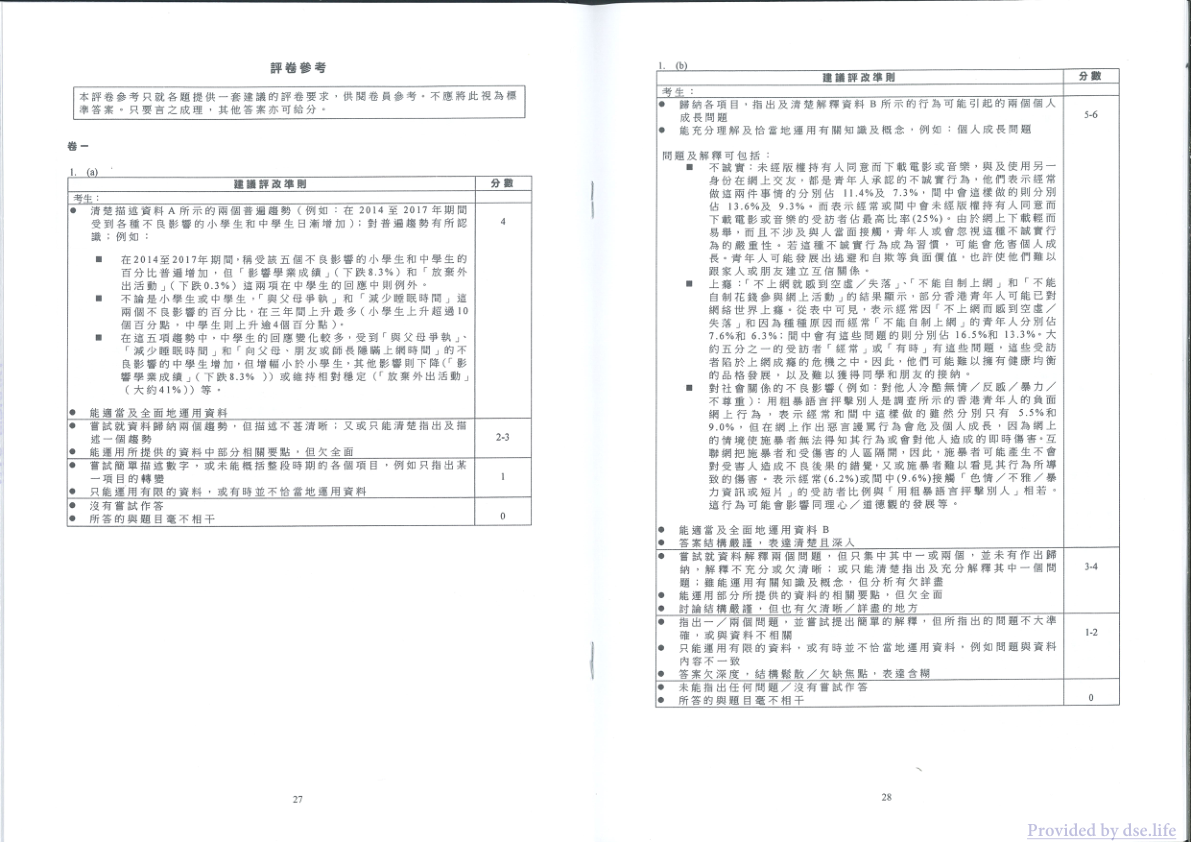
答案(英文)
Marking Guidelines
The marking guidelines will only list a set of suggested marking criteria for each question for markers' reference. They should not be regarded as sets of model answers. Alternative answers are also acceptable as long as they are reasonable.
Paper 1
- (a)
Suggested Marking Guidelines
Marks
The candidate:
clearly describes two general trends as shown in Source A (e.g. increasing percentages of both primary and secondary students, across the individual adverse effects over the period of 2014-2017); shows his/her understanding of what a general trend is, e.g.
Over the period of 2014-2017, there was a general increase in the percentages of primary and secondary school students reporting experiences in the five adverse effects, with the exceptions of ‘academic results affected’ (dropped 8.3%) and ‘give up outdoor activities’ (dropped 0.3%) among secondary school students.
For both cases of primary and secondary school students, the greatest increase in percentage points was shown in the adverse effects of ‘Quarrel with parents’ and ‘sleep time deprived’ (more than 10% among primary school students and more than 4% among secondary school student) over the three years.
The trends for secondary school students were more variable among the five items. Some of the adverse effects increased (‘quarrel with parents’, ‘sleep time deprived’ and ‘deceive parents, friends or teachers about time spent online’) but to a lesser degree than that in primary schools, while other effects showed a decrease (‘academic results affected’ (8.3% lower)) or remained relatively stable (‘give up outdoor activities’ (around 41%)), etc.
makes appropriate and full use of the source
attempts to generalise two trends from the source, but does not describe them clearly; or identifies and describes clearly only one trend
makes use of some points of relevance in the source, but not comprehensively
attempts to briefly describe the figures; or fails to make generalisations across the items/categories for the whole period of time, e.g. just indicates the changes of a single item
makes use of the source in a limited manner or sometimes inappropriately
makes no attempt to answer the question
gives an answer which is not relevant to the question
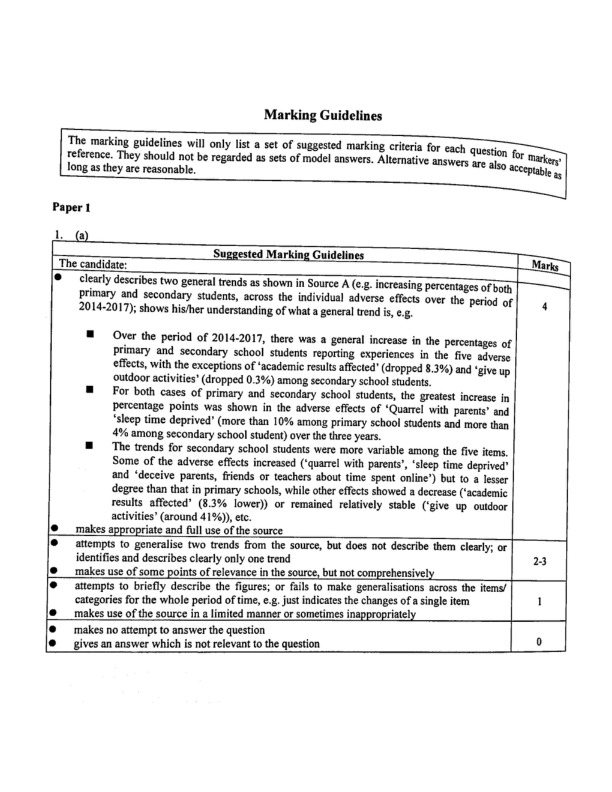
真题 Paper 1(中文)
2020-DSE 通識教育 卷一
香港考試及評核局 2020年香港中學文憑考試
通識教育 試卷一
本試卷必須用中文作答 二小時完卷(上午八時三十分至上午十時三十分)
(一) 本卷共設三題各題全答。
(二) 試題答题簿在本試卷內·把答案寫在試題答题簿中预留的空位内·寫於本試卷内的答案將不予評閱。
(三) 不可在各頁邊界以外位置書寫·寫於邊界以外的答案·將不予評閱。
(四) 宣布開考後考生须首先在试题答题薄第1页之適當位置填寫考生编號並在第1、3及5页之適當位置貼上電腦條碼。
(五) 如有必要可要求派發補充答题纸·每一張纸均须填寫考生编号填畫试题编号方格貼上電腦條码並用绳綁於簿内。
(六) 試場主任宣布停筆後考生不會獲得額外時間貼上電腦條码及填畫试题编号方格。
(七) 本科著重考核考生能否清晰簡潔及合乎邏輯地闡述和支持其觀點而非背诵资料的能力。
©香港考試及評核局保留版權 Hong Kong Examinations and Assessment Authority All Rights Reserved 2020
2020-DSE-LS 1-1
考试结束前不可将试卷带离考场
Provided by dse.life
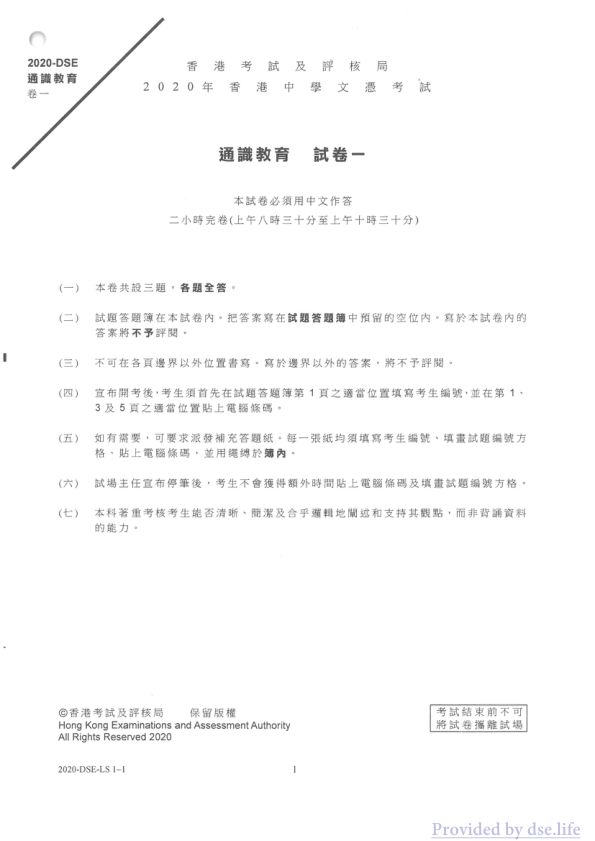
真题 Paper 2(中文)
2020-DSE 通識教育 卷二
香港考試及評核局 2020年香港中學文憑考試
通識教育 試卷二
本試卷必須用中文作答 一小時十五分鐘完卷(上午十一時十五分至下午十二時三十分)
一、 (一) 本卷共設三題,考生只須選答一題。 (二) 把答案寫在答题簿內。 (三) 本科著重考核考生能否清晰、簡潔及合乎邏輯地闡述和支持其觀點,而非背诵資料的能力。
©香港考試及評核局保留版權 Hong Kong Examinations and Assessment Authority All Rights Reserved 2020
2020-DSE-LS2-1
考试結束前不可 將試卷攜離試場
Provided by dse.life
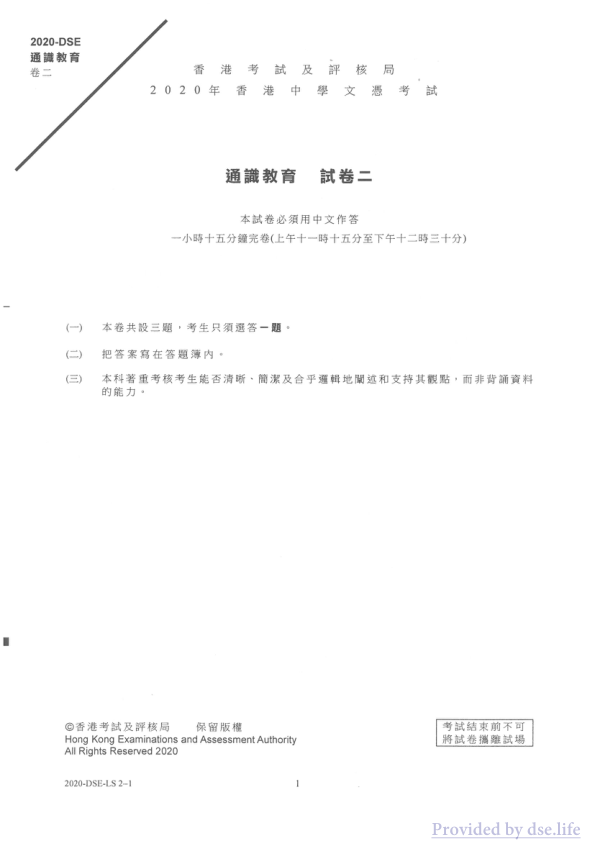
真题 Paper 1(英文)
Data-response Questions
Answer all the questions in this paper.
- Consider the following sources:
Source A
Survey Findings on the Adverse Effects of the Use of the Internet and Electronic Screen Products by Students in Hong Kong (2014 and 2017)
| Primary School Students (%) | Secondary School Students (%) | |||
|---|---|---|---|---|
| 2014 | 2017 | Changes +/- | 2014 | |
| Quarrel with parents | 41.6 | 53.1 | +11.5 | 62.7 |
| Give up outdoor activities | 27.8 | 32.6 | +4.8 | 41.7 |
| Sleep time deprived | 25.5 | 35.7 | +10.2 | 62.7 |
| Academic results affected | 32.9 | 39.0 | +6.1 | 51.6 |
| Deceive parents, friends or teachers about time spent online | 11.0 | 16.2 | +5.2 | 23.8 |
Source B
Survey Findings on the Online Behaviours of Hong Kong Young People Aged below 21 in 2017
| Often (%) | Sometimes (%) | Seldom (%) | Never (%) | |
|---|---|---|---|---|
| Feel empty/down when not online | 7.6 | 16.5 | 26.8 | 49.1 |
| Cannot stop going online | 6.3 | 13.3 | 29.8 | 50.6 |
| Cannot stop spending money on online activities | 2.5 | 5.8 | 17.3 | 74.4 |
| Download movies or music without the consent of the copyright holders | 11.4 | 13.6 | 22.6 | 52.4 |
| Use violent language to attack somebody | 5.5 | 9.0 | 23.4 | 62.1 |
| Access pornographic/indecent/violent information or video clips | 6.2 | 9.6 | 20.7 | 63.5 |
| Use another identity to make friends online | 7.3 | 9.3 | 13.2 | 70.2 |
2020-DSE-LS 1-2
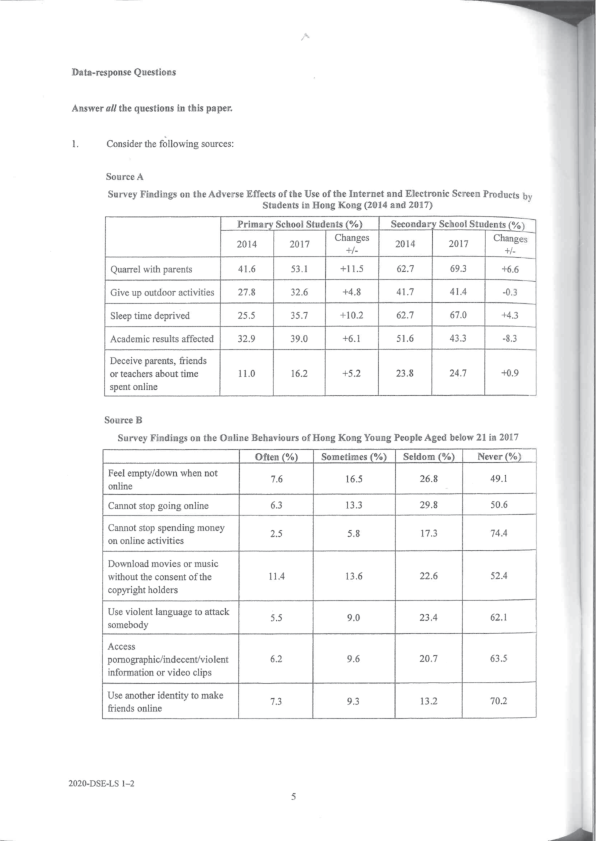
真题 Paper 2(英文)
Extended response questions
Answer one question only.
- Consider the following source:
An extract from a newspaper report dated 28 September 2017
Ten-year-old Jade grew up watching Cantonese opera with her grandmother. ‘When I watched Cantonese opera with my grandmother, I thought the headpieces, costumes, and songs were all very special, so I started to like it.’
The chief executive of the Cantonese Opera Academy of Hong Kong believes that appealing to the younger generation is important to preserve the viability of the traditional Chinese art form. She believes Cantonese opera helps preserve our cultural heritage. ‘We are actually preserving a lot of the traditional mindset. More than just preserving the messages in the opera itself, we also want to [preserve] the whole tradition and culture of performing Cantonese opera.’
The director of the Cha Duk Chang Children’s Cantonese Opera Association wants to make the subject matter more relevant to teens. ‘Cantonese opera is supposed to mirror real life, but our lives today differ greatly from the historical stories in the opera,’ she said. ‘The older generation used to read these stories, listen to them on the radio, and at night there would be an operatic performance on the same theme; it was truly a part of their life. That's why Cantonese opera is like pop music to them.’ Her organisation writes Cantonese operas that have themes and messages that connect with kids, such as an opera about a fairy who fails his exams, and must be exiled to Earth to learn from human children.
(a) Explain the difficulties in preserving Cantonese opera in Hong Kong. (8 marks)
(b) ‘Intangible cultural heritage can make important contributions to contemporary life in Hong Kong.’ To what extent do you agree with this view? Explain your answer. (12 marks)
